Consumer Price Index
Archived Content
Information identified as archived is provided for reference, research or recordkeeping purposes. It is not subject to the Government of Canada Web Standards and has not been altered or updated since it was archived. Please "contact us" to request a format other than those available.
Related subjects
-
[an error occurred while processing this directive]
Consumer prices rose 3.3% in the 12 months to April, matching the increase recorded in March. On a seasonally adjusted monthly basis, consumer prices rose 0.3% in April.
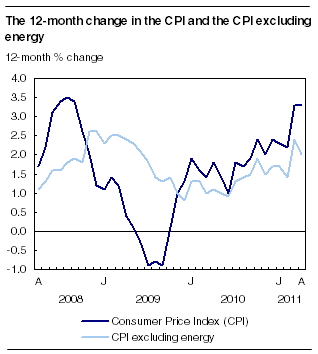
Energy prices advanced 17.1% during the 12 months to April, following a 12.8% increase in March. Gasoline prices increased 26.4%, bringing prices at the pump to a level 5.0% below the record high of July 2008. This increase followed an 18.9% gain in the 12 months to March.
Higher year-over-year prices were also recorded for electricity (+7.0%) and fuel oil (+32.4%). Conversely, prices for natural gas fell 4.8% in the 12 months to April.
Excluding energy, the Consumer Price Index (CPI) rose 2.0% in the 12 months to April, following a 2.4% gain in March. Excluding gasoline, the CPI advanced 2.2% in the 12 months to April.
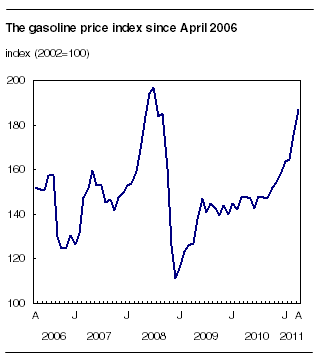
Note to readers
On June 29, 2011, with the release of the May Consumer Price Index (CPI), the basket of goods and services used in the calculation of the CPI will be updated. For more information, refer to "Consumer Price Index: A preview of the upcoming basket update," which was published in The Daily of May 4, 2011.
The special aggregate energy includes: electricity, natural gas, fuel oil and other fuels, gasoline, and fuel, parts and supplies for recreational vehicles.
The Bank of Canada's core index excludes eight of the CPI's most volatile components (fruit, fruit preparations and nuts; vegetables and vegetable preparations; mortgage interest cost; natural gas; heating oil and other fuels; gasoline; inter-city transportation; and tobacco products and smokers' supplies) as well as the effects of changes in indirect taxes on the remaining components.
Prices for food purchased from stores rose 3.7% in the 12 months to April, matching the increase in March. Several food items, in particular meat and bakery products, posted faster year-over-year increases in April than they did in March. Prices for fresh vegetables also rose in April, but at a much slower pace than the month before.
Seasonally adjusted monthly CPI
On a seasonally adjusted monthly basis, consumer prices rose 0.3% in April, after increasing 0.8% in March.
The transportation index, which includes gasoline, advanced 1.0% in April, following a 0.7% increase in March. The shelter index rose 0.5% in April, after increasing 0.1% in March.
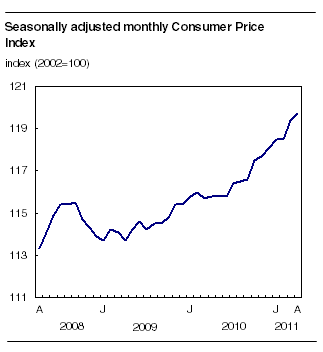
Seasonally adjusted, the food index was down 0.2% following a 1.6% advance in March. The clothing and footwear index posted a monthly decrease of 1.7% in April, while the household operations, furnishings and equipment index declined 0.7%.
12-month change: Transportation posts largest increase
On a year-over-year basis, prices increased in seven of the eight major components of the CPI in April. The only exception was clothing and footwear.
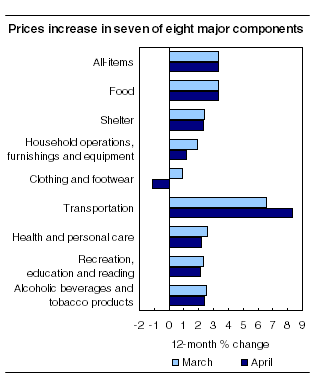
The cost of transportation increased 8.3% in the 12 months to April, the largest year-over-year gain since September 2005, when prices rose in the aftermath of hurricane Katrina. The increase followed a 6.6% advance in March. In addition to paying more for gasoline, consumers paid more in passenger vehicle insurance premiums and for air transportation.
Food prices rose 3.3% in the 12 months to April, identical to the increase in March. Consumers paid more for meat (+5.5%), bakery products (+6.7%) and dairy products (+2.4%). Prices for fresh vegetables, which tend to be volatile, increased 4.3% in April, a much smaller increase than the 18.6% rise recorded in the 12 months ending in March. Prices for food purchased from restaurants rose 2.8%.
Shelter costs rose 2.3% in the 12 months to April. In addition to higher prices for electricity and fuel oil, homeowners' replacement cost increased 2.6%. However, mortgage interest cost, which measures the change in the interest portion of payments on outstanding mortgage debt, decreased 2.1%. Natural gas prices also fell.
Prices for alcoholic beverages and tobacco products rose 2.4% in April. Cigarette prices rose 5.6%. Prices for most tobacco products increased in Prince Edward Island and New Brunswick following provincial budget measures.
Clothing and footwear prices fell 1.1%, following a 0.9% increase in March. Consumers paid less for women's clothing and men's clothing. Prices for footwear also fell.
The provinces: Gasoline a major factor in every province
Consumer prices increased in every province in the 12 months to April. Large increases in gasoline prices were observed in every province, ranging from 19.5% in Prince Edward Island to 30.1% in Ontario.
For the fourth consecutive month, Nova Scotia recorded the largest year-over-year increase in consumer prices.
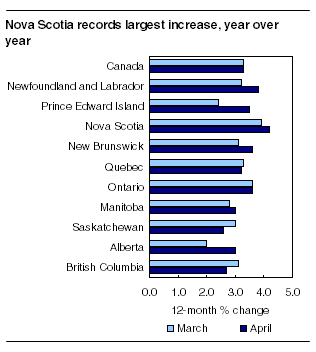
In Ontario, consumer prices went up 3.6% in the 12 months to April, matching the rise in March. In addition to higher gasoline prices, passenger vehicle insurance premiums also increased, while prices for natural gas fell.
In Quebec, consumer prices increased 3.2% in April, following a 3.3% advance in March. Drivers in Quebec paid 27.2% more for gasoline. Prices for fuel oil and meat also rose.
Prices in British Columbia went up 2.7% in the 12 months to April, following a 3.1% increase in March. Gasoline prices increased 19.8%. Consumers in the province also paid more for food purchased from restaurants, but less for natural gas.
In Alberta, prices advanced 3.0% following a 2.0% increase in March. The faster increase in April was primarily the result of a 59.6% gain in electricity prices. The large year-over-year increase in electricity costs in the province is partly explained by the fact that electricity prices in April 2010 were among the lowest recorded since 2005. As well, the recent closing of two power generation plants resulted in a significant reduction of electricity supply. Alberta consumers also paid more for gasoline (+24.0%).
The Bank of Canada's core index
The Bank of Canada's core index advanced 1.6% in the 12 months to April, following a 1.7% rise in March.
The seasonally adjusted monthly core index increased 0.2% in April, after rising 0.5% in March.
For a more detailed analysis, consult the publication The Consumer Price Index.
Available on CANSIM: tables 326-0009, 326-0012, 326-0015 and 326-0020 to 326-0022.
Definitions, data sources and methods: survey number 2301.
More information about the concepts and use of the CPI are also available online in Your Guide to the Consumer Price Index (62-557-X, free) from the Key resource module of our website under Publications.
The April 2011 issue of The Consumer Price Index, Vol. 90, no. 4 (62-001-X, free), is now available from Key resource module of our website under Publications. A more detailed analysis of the CPI is available in this publication.
The Consumer Price Index for May will be released on June 29.
For more information, or to enquire about the concepts, methods or data quality of this release, contact the Dissemination Unit (toll-free 1-866-230-2248; 613-951-9606; fax: 613-951-2848; cpd-info-dpc@statcan.gc.ca), Consumer Prices Division.
- Date modified:
